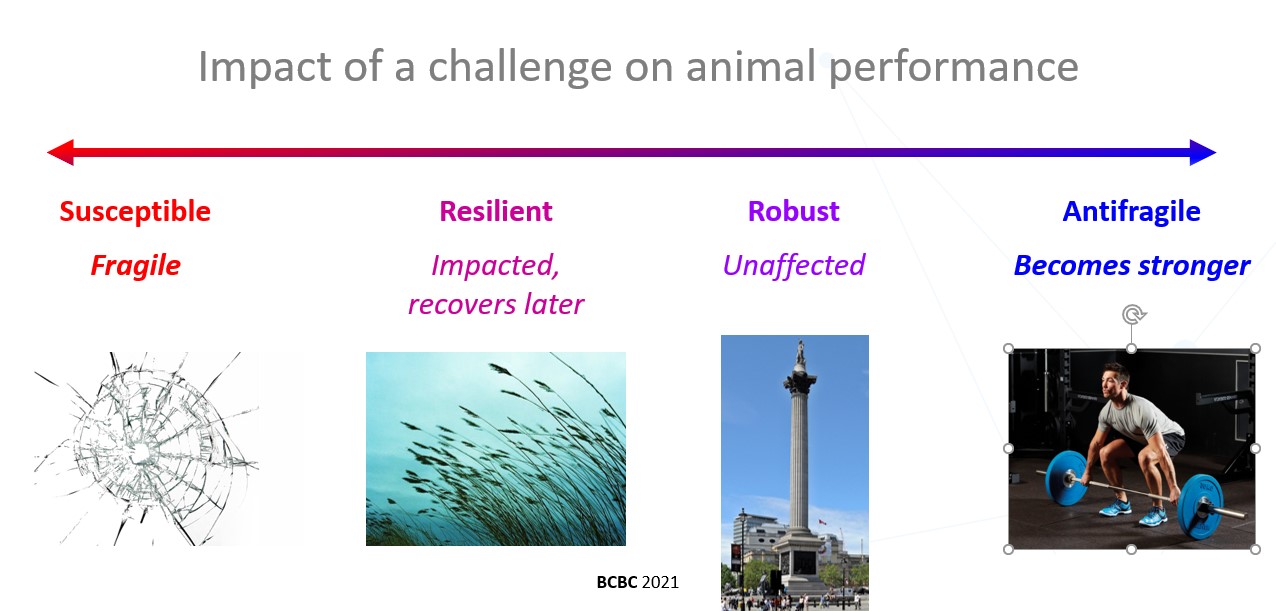
Background
Agriculture is being redefined, as we shift focus from production and productivity, to the three pillars of sustainability, Profit, People and Planet. The way we produce food and the impact this has on our wider environment will be critically important for providing a ‘licence to farm’ and for reversing current trends in climate change, while feeding our human population.
This shift warrants re-examination of the attributes animals need for a sustainable agricultural system and re-examination of how we farm them. How can we use the natural attributes that nature has shaped in animals, to deliver more sustainability farms? A key focus should be effects of the environment on animals. Farm systems vary in extent to which they control the environment, or cope with challenges it delivers. There is increasing interest in the idea of animal resilience or robustness. Do these two terms best describe what we need?
A name for an existing phenomenon
In 2012, Nassim Nicholas Taleb published a book, Antifragile: Things That Gain From Disorder. He coined a name for a phenomenon that had no English word: antifragile. He showed this is important in many systems, from investment and economics through human behaviour to basic biology. It is best considered as a long-term or permanent response to a challenge (Figure 1).
Figure 1: From fragile to antifragile – possible responses to challenge. From fragile (adverse impact, long-term) through resilient (bends and bounces back) and robust (imperturbable) to antifragile (emerges stronger).

Fragile systems suffer permanent ‘damage’ with functionality reduced (e.g. productivity or longevity). A good example is permanent effect of a poor rearing season on adult size of one birth cohort compared to others. Resilient systems show a short-term reduction in performance but bounce back, while robust systems show no effect of the challenge. Antifragility is an even better response. In this case, challenge leads to a stronger system that outperforms the pre-challenge state. Neither resilient or robust adequately explain this phenomenon.
Is antifragility real?
Antifragility is real. It is the basis of how immunity functions, how training improves the performance of athletes and how learnt behaviour allows animals to avoid the worst of life’s challenges. It may explain why animals raised in challenging conditions often outlive those raised in easy conditions.
Some may define antifragility as toughening and fragility as brittleness. In an engineering sense, antifragility is where challenges makes structures stronger, however only living systems can do this because nature has shaped them to do so.
Antifragility is the idea behind the saying ‘What doesn’t kill you, makes you stronger.’
Why is antifragility important?
Animals are farmed in environments that vary, to varying degrees. We should see challenge as something of value, where it makes animals better able to cope with future challenges.
Where environments are variable, antifragility, allows local adaptation. We should view environmental variation as good where advantages are delivered. Common and ‘reasonable’ challenges which exploit an animal’s innate ability to respond in an antifragile way should be valued. Stronger performance in future may outweigh the short-term cost of a challenge.
How does antifragility work?
For immunity, immunological memory prepares animals to mount an effective response to future challenges of the same type. Learnt behaviour uses a different type of memory. Rats in a maze learn to get through the maze faster and more easily to get the reward. For cows, it is how they avoid troublesome interactions with dominant animals in a herd or how they know the best parts of a field for grass. Exercise is probably the example we best relate to. Loading the body leads to signals interpreted as a need to build stronger bone and muscle.
There is evidence that feeding regimes, where both quantity and quality vary, may lead to better physiological control of body weight (the idea behind the human 5–2 diet). Might this idea help improve feed efficiency in livestock?
Epigenetics has shown us how environment affects gene regulation and gene effects are manifest. We know that it affects proteins folding, and so how they interact with other proteins in the body.
We need to quantify the effect of environmental challenges on future performance of livestock, in terms of feed efficiency, productivity (growth, reproduction, lactation and health), in the long-term, and on longevity itself. In particular the effects of weather, feeding level and disease challenges should be studied. Modern tools for precisely monitoring nutrition, the environment, health and performance of individual animals, throughout their lives will allow us to do this.
How can we use antifragility?
An antifragile response is a sign of adaptability at the level of the individual. It delivers benefits when farming in a variable environment. So how do we incorporate antifragility into a basket of traits to define overall merit in the long-term? Some outcomes, like disease resistance and longevity, may indicate expression of antifragility. While, long-term responses define antifragility, shorter term responses in these and other traits may prove to be good predictors.
Variable environments are the norm for some classes of livestock farming e.g. outdoor or more extensive pastoral based systems. Rather than thinking we should protect animals from most challenges, we should perhaps define ‘good’ levels of challenge that strengthen future animal performance. It is highly likely that this already happens in outdoor systems to some degree, even if we do not deliberately try to gain an antifragile response. It may explain why experienced farmers say animals reared in more challenging environments shift well to easier country, but not vice versa.
An animal’s ability to mount an antifragile response is likely to bear a cost. This is a sort of ‘insurance policy’ against challenges negatively impacting on performance in the long-term. A narrow focus on productivity may limit an animal’s ability to adapt when challenged. Arguing that more production is best ignores the fact that environment challenges impact on animal performance.
Can we exploit antifragility in livestock management?
Animals are not machines that perform at a level related to just feed inputs. The reason we farm animals is that they can roam across land and utilise feed that we as humans would obtain much less benefit from. In doing so they encounter environmental challenges but have innate systems designed to cope with those commonly encountered. This natural ability to respond to environmental challenge is something we can take advantage of, rather than seeking to control the environment.
For farming cattle, we should consider what level of production is right, for a given cow size, in a given environment. More challenging environments will most likely have a lower target for this. The aim here is to use the animal’s natural ability to cope with challenge rather than bearing the cost of eliminating the challenge through controlling the environment.
We need to know what levels and patterns of challenge lead animals to perform better over the long-term. A key question is what challenges are helpful as opposed to those which exceed an animal’s ability to deliver an antifragile response. Animal science needs to quantify the size of effects and the range of challenges we can manage to deliver benefits from antifragility.
Some relevant questions are:
- How do we define and measure antifragility?
- What levels of pathogen challenge best potentiate the immune system?
- Is there a pattern of variation in feeding level that best ‘tunes’ control mechanisms animals have to prioritise nutrient partitioning for production, reproduction, health and managing body reserves, while making efficient use of feed?
- What patterns of weather (rain, wind and temperature) potentiate animals for better behaviours and better control of body processes when challenged in the same way later?
- How do we manage herd behavioural dynamics to reduce negative interactions? Are there positive outcomes to these interactions we are failing to see?
It is about living with environmental variation and exploiting the response it can deliver as antifragility. Effectively antifragility is an ‘output’. We want animals to have this potential and use it to overcome environmental challenges, quickly and easily.
Can we exploit antifragility in genetic improvement?
Mounting an antifragile response is ‘adaptable’. Adaptability is also a population attribute, where variation between animals allows a population to respond to a changing or different environment. Antifragility is more short-term, acting on the individual. Antifragility is within animal adaptability.
International genetic evaluations have shown animals adapted to more challenging environments do not perform as well as those that are not, when those challenges are removed. The converse can be true when assessed with those challenges. Is this difference explained by antifragile responses?
Antifragility as a concept may help interpret data used in genetic evaluation and add value to formulation of breeding objectives for sustainable livestock systems.
Some questions for animal genetics are:
- Can we select for potential to manifest antifragility?
- How should we farm elite genestock to assess potential to express antifragility?
- Does antifragility explain some of the noise in datasets used for genetic evaluation? e.g. bulls reranking when progeny are run in more challenging conditions?
- Can new models for analysing data estimate size of antifragile effects and identify genes or gene combinations that potentiate animals to stronger antifragile responses?
- How do we account for benefits from antifragile responses when defining genetic merit?
Conclusions
Antifragility may be part of the solution for lower impact livestock farming. It can help animals cope with expected challenges and reduce costs incurred by managing the environment. Environmental variation is natural and animals have evolved systems to cope with this and thrive.
Environmental challenges can have advantages as well as disadvantages. We should evaluate the benefits of environmental challenge, not just harm. Antifragility is a positive outcome from a less than ideal situation. However, it may be better interpreted as variable environments are best because they deliver antifragile benefits i.e. challenges are good when they lead to animals becoming more efficient, healthier or longer lived.
Antifragility is real phenomenon but we do not know enough yet to advise livestock managers on how to use environmental challenges to improve livestock performance.
Antifragility may explain why animals with extreme merit for high productivity are less suited to a variable environment and more suited to highly controlled environments. We need to know more about trade-offs, if any, between productivity and the ability to deliver antifragile responses.
Defining the genotype of ‘sustainable livestock’ should consider exploiting antifragile responses. To do this, we need to know how to best characterise it? A challenge is to define breeding objectives that allow animals to adapt to environmental challenge. However, traits like disease resistance and longevity, outcomes that antifragility affects, will help do this.
Acknowledgements
Views in this paper are those of the author alone. I have benefitted from talking to different people about the idea of antifragility as applied to livestock. More thinking is needed to see how this can be used best to manage cattle and to define breeding objectives for cattle of the future.
Reference
Taleb, N.N. (2012). Antifragile: Things That Gain From Disorder. Penguin Publishing. 519pp.